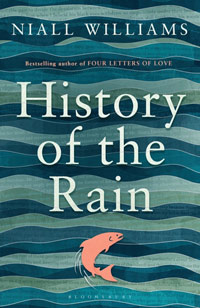Book Review: History of the Rain
Niall Williams Brings an Irish Family’s Story to Vibrant Life
History of the Rain, the ninth novel by Niall Williams, is told from the point of view of Ruth Swain, a precocious, bedridden (leukemia? the doctors can’t make up their minds) 19-year-old girl literally surrounded by her father’s books. There are thousands of books — from Aeschylus and Dante to Shakespeare and Milton, Dickens and Yeats, Austen, Joyce and Faulkner, and every significant author in between; books her father purchased in secondhand shops or were given by neighbors; books that accompanied him on his voyages to distant ports or traveled in his coat pocket as he tended his cows. (Virgil Swain has the distinction of being the only person in Faha parish, Derry, who reads the poems of William Blake to his cows.) Through this prodigious collection, the marginal notations, the passages underlined in pencil, Ruth discovers her father’s inner life: “The library that grew in our house contained all my father’s idiosyncrasies, contained the man he was at thirty-five, and at forty, at forty-five.”

The collection is also the lens through which Ruth views and interprets her provincial world, and the people who populate it; local characters are invariably compared with characters from literature. No author’s work is better for this purpose than Charles Dickens, and Ruth turns often to this rich source.
As much as it is a land of rain, mist, and rivers, Ireland is first and foremost a land of words —stories, folklore, and poetry. Ruth says, “We tell stories. We tell stories to pass the time, to leave the world for a while, or go more deeply into it. We tell stories to heal the pain of living.” The Swains are not strangers to tragedy and loss. Ruth’s twin brother drowns in a river, the family home catches fire and burns, and, driven by incessant rain, the river overwhelms its banks and floods the farm.
In a voice by turns perceptive and hopeful (even if that’s hope with a small “h”) though never self-pitying, Ruth relates these unfortunate occurrences as part and parcel of being born a Swain, whose way, going back to the Reverend Swain, is the long upward climb against one’s own limitations. The Swain family story — brought to vibrant life by Williams — is everyone’s story; it’s about how we aspire and endure. If we are very lucky, and very loved, someone will keep our memory alive through the telling of our story.



